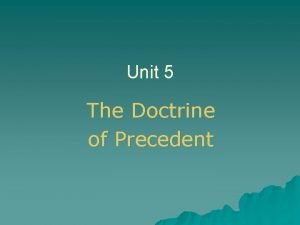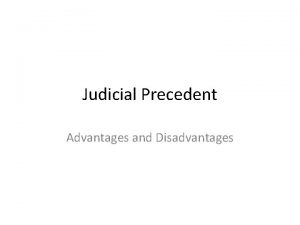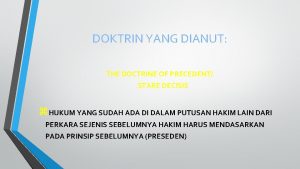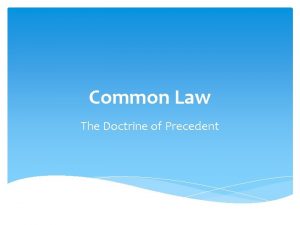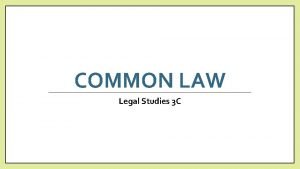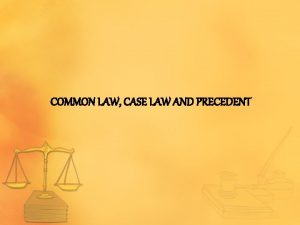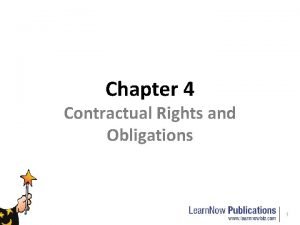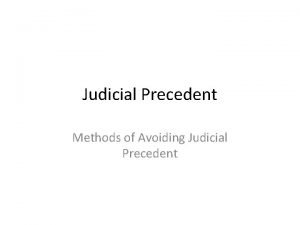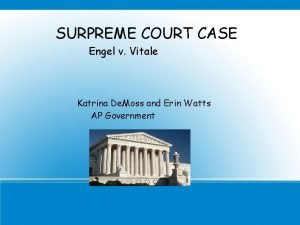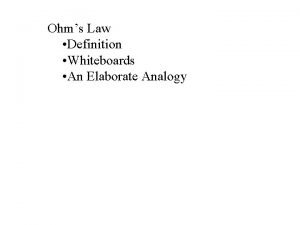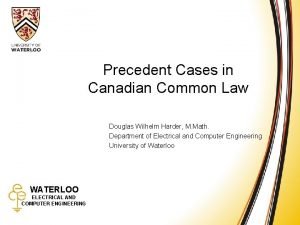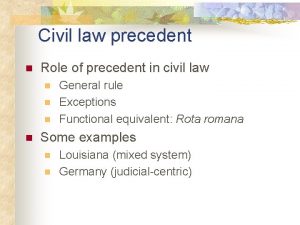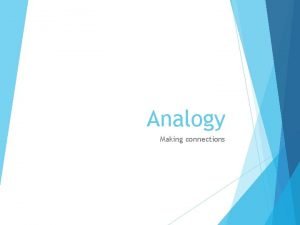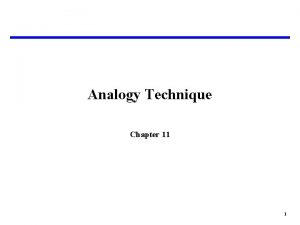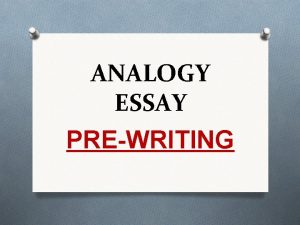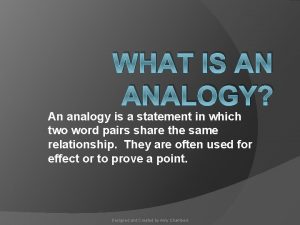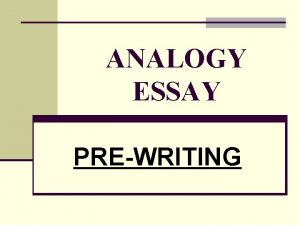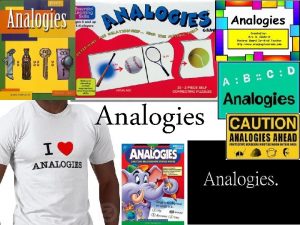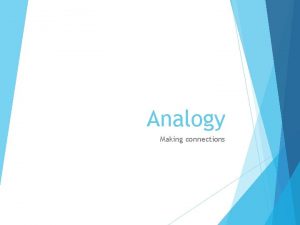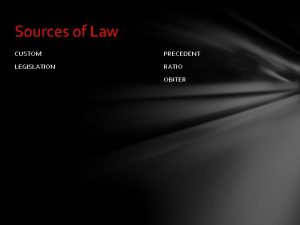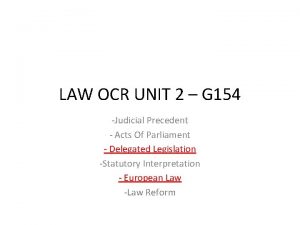Analogy Precedent Prep for Law 2014 Module 10















































- Slides: 47

Analogy & Precedent Prep for Law 2014 Module 10 Based on Excerpt of Martha Minow’s “Analogy and Precedent”

One of the most distinctive elements of legal reasoning stems from the use of precedents. Prior judicial opinions have authoritative weight and yet law does change. Learning how this process works and becoming adept at using and distinguishing precedents is thus crucial to legal education. Precedential reasoning actually is a specific instance of a larger reasoning process: reasoning by analogy. Indeed, lawyers and judges pervasively draw comparisons among and distinctions between patterns of facts and concepts. These materials show vivid examples of analogical and precedential reasoning drawn from first-year courses materials with easy connections to full case opinions through on-line searches. Also included is a step-by-step guide to the use of analogies and disanalogies in law. A survey of criticisms leveled against reasoning by analogy in law is followed by some defenses. A final element offers exercises designed to sharpen your ability to reason by analogy about legal issues. Watch and listen for the visual and audio materials, included for fun and instruction.

Compare discussions of a difficult public issue as conducted in a law school with discussions of the same issue in a business school or public policy school. Take, for example, the issue of "surrogate motherhood" (sometimes called, "contract pregnancy"). Should society permit and enforce agreements in which a woman promises to become pregnant using the sperm of the man proposing the contract, to carry the pregnancy to term, and to turn the baby over to the man (and usually his wife) in exchange for money? Discussions in a business school or public policy school are likely to explore the social consequences of such agreements. How are they likely to affect the availability of babies for families that want them, the value of women's labor, and perhaps, the societal views of children, pregnancy, and women's bodies?

These themes are bound to arise in a law school classroom, too, but so will a very different line of analysis. Law students find courts and legislatures asking questions such as: Is surrogate motherhood more like baby selling, which is forbidden by law, or an employment contract, which is lawful? Is the baby more like goods that can be freely exchanged in the marketplace, or more like human tissues and organs, about which there is great controversy? Is the surrogate mother who changes her mind and wants to keep the baby more like a woman who has agreed to place her expected child up for adoption -- and by law is allowed a grace period within which to change or mind -- or like a seller who agreed to provide a unique good -- and by law may be compelled to do so? These questions all draw comparisons between the surrogacy context and other contexts already settled by law. These questions, in short, pose analogies to precedents, decisions that have already been made.

Treating a disputed case by reference to the settled treatment of a prior case is a familiar instance of reasoning by analogy in law, although lawyers and judges also make analogies with sources besides prior judicial opinions. Legal reasoning makes use of analogies to precedents for three reasons. The first is a commitment to equality: like cases should be treated alike; unlike cases should be treated differently. The second reflects a conception of the "rule of law" as an ideal; issues should be resolved by reference to established standards rather than whim. This ideal promotes predictability for people affected by law and accountability by people who implement law. Predictability and accountability are values independent of correct or even marginally better solutions to problems. The third reason behind law's use of analogies stems from their effectiveness in producing answers to problems that can be perplexing and divisive. Reasoning by analogy can prompt a flash of insight about how to respond to a case in doubt. This is especially helpful when the analogy stems from a pre-existing, authoritative decision; being able to point to past authoritative decisions that seem similar helps to prompt and justify decision in a sea of otherwise competing considerations. Reasoning by analogy serves law's basic goal of resolving practical problems while sustaining a relatively predictable and fair system for solving problems in the future. At different times, and within different legal communities, particular analogies or analogies in general may hold more or less persuasive power or seem more or less gripping. Yet their distinctive presence in legal reasoning justifies a closer look at how lawyers and judges use analogies.

How Reasoning By Analogy Works in Law Reasoning by analogy works by inferring from the recognition that two items share some traits that they share an additional trait that one of them is known to possess or by judging that because two items share some traits they should be characterized or treated in a similar way. To be persuasive, the comparison must appeal to a sense or intuition that the additional trait is likely to accompany the existing traits, or that it would be wise to treat the two items similarly on the issue in dispute. Edward Levi's classic book, An Introduction to Legal Reasoning uses the history of common law cases that address what kinds of objects are inherently dangerous to demonstrate a process of reasoning by example. He traces a historical line of cases that address when tort liability should fall on manufacturers for injuries their products cause. This history illuminates reasoning by analogy as one of the central methods in developing the common law. Judges ask questions, such as, given a case deciding that a train is inherently dangerous, but a wagon is not, how should a car be viewed?

How Reasoning By Analogy Works in Law The comparison may appear to proceed at a fairly concrete level. If we compare the physical qualities of the car with the train and the wagon, the car may seem more like the train given both are made of metal rather than wood. The car may seem more like the wagon in that each has only four wheels and span about the same length. The train, on the other hand, has an engine that pulls multiple cars. Yet even such concrete comparisons presuppose some relevant normative force or principle. Thus, the common law judge may intuit that vehicles that are subject to less physical control should be more carefully regulated by law; the train pulling multiple cars is inherently dangerous because there is relatively less control over its motion than there is over a single wagon -- and an automobile is more like the wagon in this respect. Alternatively, the train is inherently dangerous because it moves so quickly and can cause such damage upon impact with a stationary object or person; the auto is more like the train than the horse-drawn wagon in this respect and should be treated the same way.

How Reasoning By Analogy Works in Law The comparison explicitly may pursue more functional or sociological lines. Who uses the car, who controls it, and how does that compare with who uses and controls the train and the wagon? The comparison may invite predictions about risks of injuries from each vehicle or risks of fatal injuries from each; the chance of harm and the scope of harm are related but distinct concerns. The comparison might direct an inquiry into the social relations that surround the vehicles: what are the dealings between manufacturer, seller, operator, and victim for each, and who in each circumstance has most control over the risk of accidents? Again, implicitly, these comparisons point back to some norms about how to allocate risks, assess harms, and produce incentives for care or for redistribution of the costs of accidents.

How Reasoning By Analogy Works in Law Thus, implicitly many of these comparisons direct attention to the purposes of the rule. One rule would state, "Producers of dangerous objects should bear the costs of accidents involving them. " This rule might serve the purpose of giving produces incentives to reduce the risks or might instead advance the goal of spreading the costs of accidents through the prices the producers can set for the objects. A contrasting rule would indicate: absent a special danger, a producer should face liability only for negligent failures of care, not strict liability for any damage resulting from use of the product. This rule might serve the purpose of promoting greater caution by consumers, more investment in new products, reducing the price of new products, or allowing greater freedom for producers. Yet rather than trying directly to fit the new case -- the car accident -- under an already articulated rule and one or more of its purposes, reasoning by analogy proceeds, at least for a while, by comparisons with instances that have, and have not, fallen under the rule in the past. In this way, reasoning by analogy can bring to mind allow simultaneous consideration of more than one purpose, or a purpose and a social practice, or a purpose and a prediction of how the world operates. Juggling elements with the template of a comparative example helps prompt intuitions about their sensible bearing on the contested situation.

Examples of Analogical Reasoning in Judicial Opinions Notable case law examples of reasoning by analogy appear in influential judicial opinions. Consider these examples from contracts, torts, property, criminal law, civil procedure, and constitutional law:

Analogy in Contracts In Frigaliment v. B. N. S. Int'l Sales a buyer sued a seller of chickens after entering into two contracts; one called for a certain quantity of heavier chickens, at a lower price, and the other called for the delivery of a certain quantity of lighter weight chicken at a higher price. Younger, tastier chicken could come in either weight while older, less tasty chicken came only in the heavier weight. The seller had sent the buyer both younger and older chickens. The buyer sued, claiming the contract was for only younger chickens. In his opinion for the court, Judge Henry Friendly offered this analogy: "Plaintiff says the [lighter] birds necessarily had to be younger chicken since the older birds do not come in that size, hence the [heavier] birds must likewise be young. This is unpersuasive -- a contract for 'apples' of two different sizes could be filled with different kinds of apples even though only one species came in both sizes. "

Analogy in Torts In Adams v. New Jersey Steamboat Co. , a steamboat passenger sued the owner after theft of valuables from the rented cabin; neither passenger nor owner had been negligent. The passenger claimed the owner nonetheless was strictly responsible, regardless of any failure or compliance with care, in light of prior case ruling that innkeepers were strictly liable for theft of boarders' valuables. The owner argued against strict liability and pointed to precedents rejecting liability claims by passengers on open-berth sleeping trains. For purposes of liability for theft from a passenger, should the steamboat owner be viewed as more like the innkeeper or more like the train owner? The court reasoned that "A steamer carrying passengers upon the water, and furnishing them with rooms and entertainment, is, for all practical purposes, a floating inn, and hence the duties which the proprietors owe to the passengers in their charge ought to be the same. " The court noted that both innkeepers and steamboat operators are entrusted with high levels of confidence in the face of temptations by many to endanger guests. Given this parallel relationship to guests, innkeepers and steamboat operators should bear the same kinds of duties to guests.

Analogy in Property Is the income-enhancement value of a professional degree the kind of property interest covered by a statutory rule of equal division of the partners' property upon divorce? The New York Supreme Court answered affirmatively in O'Brien v. O'Brien, after analogizing the license to practice medicine to unmatured pension rights. Both represent expected streams of earnings; both would have contributed to the economic partnership of an ongoing marriage; both, reasoned the court, should be part of the economic pool available to both spouses if the marriage ends.

Analogy in Criminal Law The Supreme Court had applied the Fourth amendment's requirement of a warrant before a police search or seizure to searches of a house but not to searches of a car. In California v. Carney, the Court faced the question of whether the warrant requirement applied to a motor home parked off the street. Here the Court had two alternative cases for reasoning by analogy, and thus asked whether the motor home was relevantly more like a house or more like a car. The Court considered reasons for exempting car searches from the warrant requirement: ready mobility, a lower expectation of privacy, pervasive regulation of public highways, and concluded that these also applied to the mobile home. In this instance, use of analogy visibly prompted elaboration of reasons supporting the settled case to help align the disputed case of mobile homes with the treatment of cars.

Analogy in Civil Procedure The doctrine of res judicata -- claim preclusion -- directs that a judgment on the merits of a controversy bars subsequent actions between the same parties upon the same claim. Discerning what suits should be precluded often engages courts and parties in analogical reasoning. For example, when a plaintiff filed suit against the state and alleged a due process violation in his termination from public employment, the court found his claim barred in light of his previous filing of a similar claim in a court which ruled that his remedy lay entirely within the state agency handling unfair labor practices. The state court found persuasive an analogy to a prior case in which the plaintiff's claim arose from the termination of his worker's compensation benefits; in both cases, the proper relief was available before a state agency and a prior court decision had said so.

Analogy in Constitutional Law In Bowers v. Hardwick, the Court analogized prosecution for consensual adult sodomy in the home to prosecution for possession of illegal drugs in the home. The Court reasoned that just as the sheer fact that the proscribed conduct occurs in the home would not bar prosecution for drug possession, neither should the occurrence of sodomy in the home bar prosecution. The Supreme Court considered in Tinker v. Des Moines Independent School District, whether the First Amendment could countenance a decision by school officials to forbid the wearing of armbands by student to protest the Vietnam War. In the Court's opinion, upholding the students' First Amendment freedoms, the Court analogized the restriction to a hypothetical school regulation "forbidding discussion of the Vietnam conflict, or the expression by any student opposition to it anywhere on school property except as part of a prescribed classroom exercise" which would violate students' rights of free expression.

Analogical Reasoning & Interpretation of General Rules The same process of reasoning by analogy is commonly used by lawyers in interpreting not only cases, but also statutes, and other general rules announced in advance. Consider this example: A municipal ordinance states "Any person who brings a vehicle into the public park shall be fined $100. " The ordinance was applied against a person who rode a motorcycle into the park. Should it apply now, by analogy, to a person who rides a skateboard through the park? Another who walks a bicycle through the park? A third who uses a wheelchair in the park? An electric wheelchair? Another who drives an ambulance in the park to respond to an emergency? Again, the process of comparing the new situations to the one already yielding a decision call for physical comparisons, functional ones, sociological, or purposive ones.

Analogical Reasoning & Interpretation of General Rules All these examples suggest the ways that common law development and statutory interpretation both pursue the equality norm -- treating like cases alike. Both also aspire to the ideal of the rule of law while producing actual decisions in hard cases. This means that lawyers and judges reason case-by-case and interpret general rules not just to achieve good results specific to each occasion but also to produce and sustain predictable governance that puts people on notice in advance of the consequences of their actions. These goals could be jeopardized if analogical "reasoning" was just a kind of Gestalt response to the particulars of each case. To serve the goals of good results and fair notice, analogical reasoning, especially as part of system of precedent, must and does make implicit reference to norms that themselves can undergo clarification and refinement through application.

Literary Analogies and Metaphors Analogies, quite apart from precedents, also inform legal reasoning and supply rhetorical force in lawyers' arguments and judicial opinions. Sometimes, a lawyer may try to use a global analogy to take the entire legal situation and compare it with a nonlegal one in order to elicit sympathies from the decision maker. Literary theorist Wayne Booth was so struck by this analogy, used by a lawyer, that he used it in an essay on rhetoric: "A lawyer friend of mind was hired to defend a large Southern utility against a suit by a small one, and he thought at first that he was doing fine. All of the law seemed to be on his side, and he felt that he had presented his case well. Then the lawyer for the small utility said, speaking to the jury, almost as if incidentally to his legal case, "So now we see what it is. They got us where they want us. They holding us up with one hand, their good sharp fishin' knife in the other, and they sayin, ' 'you jes set still, little catfish, we'rejes going to gutya. '" At that moment my friend reports, he knew he had lost the case. "

Literary Analogies and Metaphors Actually, this comparison is offered as a metaphor, a condensed analogy that skips the step of the explicit comparison and simply treats the two instances as identical. Rendered as an analogy, the lawyer's point would be: "the large utility is to the fisherman as the small utility is to the catfish" and "the knife is to the catfish's vitality as the large utility's conduct is to the small utility's vitality. "

In his famous "Letter from a Birmingham Jail" Reverend Martin Luther King, Jr. responded with analogies to charges that his civil rights effort should cease because it caused violent reactions: "In your statement you assert that our actions, even though peaceful, must be condemned because they precipitate violence. But is this a logical assertion? Isn't this like condemning a robbed man because his possession of money precipitated the evil act of robbery? Isn't this like condemning Socrates because his unswerving commitment to truth and his philosophical inquiries precipitated the act by the misguided populace in which they made him drink hemlock? Isn't this like condemning Jesus because his unique God-consciousness and never-ceasing devotion to God's will precipitated the evil act of crucifixion? We must come to see that, as the federal courts have consistently affirmed, it is wrong to urge an individual to cease his efforts to gain his basic constitutional rights because the quest may precipitate violence. Society must protect the robbed and punish the robber. "

Literary Analogies and Metaphors Lawyers and judges often use similes, metaphors, and other figures of speech to give a more immediate and vivid feel to what would more fully be expressed as an analogy. Oliver Wendell Holmes, Jr. , once compared the property doctrine of adverse possession as an effort to protect the expectations of someone who has occupied another's land for a long time and who thus has come to be "like a tree in a cleft of a rock [which] gradually shapes his roots to his surroundings, and when the roots have grown to a certain size, cannot be displaced without cutting at his life. " "Juliet is the Sun, " Romeo tell us, and we see then how a loved one can be the center of one's life. Of course, you may think instead that this metaphor means that Juliet lights up Romeo's life, or that he finds her distant, or hot; these kinds of ambiguities are part of the territory that comes with metaphors.

Literary Analogies and Metaphor Sometimes, despite or even because of its ambiguity, the simile or metaphor seems to do even more of the work of reasoning, or prompting recognition of factors or values that should matter. Thus, in an influential opinion, one federal court developed the metaphor connecting the executive headquarters of a corporation and the "nerve center" of an organism to help fix the location of the corporation's principal place of business for purposes of diversity jurisdiction "Where a corporation is engaged in far-flung and varied activities which are carried on in different states, its principal place of business is the nerve center from which it radiates out to its constituent parts and from which its officers direct, control, and coordinate all activities without regard to locale, in the furtherance of the corporate objective. " When asked to treat automatic vending machines as retail stores to satisfy the "retail establishment" exemption to federal fair labor standards, a federal court refused with this reasoning: "The individual automatic vending machines cannot be realistically likened to independent retail stores. They are rather silent and automatic salesmen offering at retail the goods of a single enterprise. . 'The machine is the mechanical arm of the operator who sells directly to the customer. '"

Steps of Analogical Reasoning In each of the contexts of case reasoning, statutory interpretation, and global rhetorical comparisons, analogies operate through three basic steps, all responding to a sense of doubt or uncertainty about a how to treat or view an instance or problem. How to Construct an Analogy Step 1: Articulate a proper base point for comparison with the instance in dispute. Step 2: Identify similarities and differences between the base point and the disputed instance. Step 3: Determine whether to treat the two instances the same because the similarities outweigh the differences or to distinguish them because the differences prevail.

How to Construct an Analogy Step 1: Articulate a proper base point for comparison with the instance in dispute. Step 2: Identify similarities and differences between the base point and the disputed instance. Step 3: Determine whether to treat the two instances the same because the similarities outweigh the differences or to distinguish them because the differences prevail. The second step is to identify the relevant similarities and differences between the base point and the disputed instance. The third involves determining whether the similarities are sufficiently greater than the differences to treat the two instances the same or to instead distinguish them. For some people, the second step and the third step are identical. Finding the similarities and differences, to them, determines the conclusion about how to treat the disputed instance. Yet, this approach would better describe “identities” than analogies; that is, circumstances that actually are identical. Where analogy makes a contribution is where the disputed instance actually differs in some noticeable and worrisome way from the comparison point. Recent work in cognitive theory suggests that analogical reasoning is an instance of problem-solving methods that match patterns in the environment with stored schemas for solutions or solution procedures.

How to Construct an Analogy Step 1: Articulate a proper base point for comparison with the instance in dispute. The first step is identifying a proper base or example as the point for comparison with the instance in dispute. This base point could be a judicial precedent, a prior instance of statutory interpretation, or an example from common sense or lay understanding. Finding this point of comparison may involve a flash of insight, or instead a deliberative review of a range of potentially relevant sources for drawing comparisons with the disputed instance. Step 2: Identify similarities and differences between the base point and the disputed instance. Step 3: Determine whether to treat the two instances the same because the similarities outweigh the differences or to distinguish them because the differences prevail.

Reasoning by Disanalogy The three steps of 1) locating a base for comparison; 2) identifying similarities and differences between the base and the disputed instance; and 3) determining whether the similarities are more weighty than the differences are also used in the process of reasoning by disanalogy. Here the base point is used to demonstrate why the disputed instance is sufficiently different to warrant treatment different than that accorded to the base point. Consider this in the context of inherently dangerous objects. Let's assume that a gun has already been treated as an inherently dangerous object. Should a lamp that exploded be treated similarly as an inherently dangerous object? Perhaps we note that the gun was designed to injure while the lamp was not.

Reasoning by Disanalogy Perhaps this helps us to realize that this element -- being designed to inflict harm -- is crucial to the conclusion that the gun should be treated as inherently dangerous, thus exposing its manufacturer to a strict duty for injuries the gun causes. The absence of this element -- the lamp was not designed to inflict harm -- suggests that the producer of the lamp should not be treated as strictly liable for injuries the lamp may cause. Reasoning in this way may imply a continuum that starts with the precedent or obvious case, then moves away towards a less similar case and then continues on toward one that is clearly different. (37) Perhaps a lighter is a middle-case, somewhere between the gun and the lamp, on the precise dimension of "designed to produce harm. " The lighter was designed to produce fire, which can harm, but the lighter itself was intended not to harm but to enable easy igniting.

Reasoning by Disanalogy Distinguishing a proffered analogy involves emphasizing a difference; sometimes, the reasoning by disanalogy helps illuminate a trait in the base or settled example that was not previously emphasized but now seems crucial, given its contrast with the contested case. Here an examples from contracts, property, and civil procedure.

Disanalogy in Contracts In Mills v. Wyman, the court addressed whether a father was obliged to repay a "good Samaritan" for expenses incurred in caring for the father's son when the son was near death. The father promised to make this payment but made the promise after the services were rendered. Some precedents indicated that no promise is legally enforceable if made after the fact of the proffered services; others in contrast, suggested that moral consideration could count as a basis for enforcing such a promise. On further review, the court in Mills found that all the cases treating moral consideration as adequate to enforce a promise involved prior "valid" consideration that had been extinguished by law, such as a legally enforceable promise to pay a debt that had been extinguished by discharge in bankruptcy. No enforceable promise remained and yet the moral obligation could supply the missing element. But the father in Mills had no such prior but now extinguished consideration; on this basis, the precedents favoring enforcement could be distinguished as disanalogous. They included a crucial trait missing in this case.

Disanalogy in Property In Moore v. Regents of the University of California, the plaintiff claimed that his physician, hospital, a researcher, a research firm, and a pharmaceutical company made use in their own profitable venture, without his permission, of cells removed from his body in the course of medical treatment. The plaintiff argued that the defendants therefore wrongly appropriated something that belonged to the plaintiff. The plaintiff argued that he had a proprietary interest in his own genetic material the same way the courts have recognized the proprietary interest each person has in his own likeness. The majority rejected this analogy, however, on the grounds that one's likeness is unique but one's genetic material for producing lymphokines are identical in all people: "it is no more unique to Moore than the number of vertebrae in the spine or the chemical formula of hemoglobin. "

Disanalogy in Civil Procedure Personal jurisdiction, governed by the due process clauses, limits judicial power to defendants who have "minimum contacts" with the forum state, with the further limitation that the exercise of jurisdiction must be compatible with traditional notions of fair play and substantial justice. Application of this test in practice often engages courts in drawing analogies and disanalogies with the fact patterns of prior cases. Thus, in Calder v. Jones, ) the Supreme Court faced whether a state court in California could exercise jurisdiction over the editor and reporter for the National Enquirer after the entertainer Shirley Jones sued them for libel. Although 12% of the paper's circulation occurs in California, the reporter and editor were Florida residents who had taken no California trips related to the story in question. The Court considered but rejected the defendants' effort to analogize their situation to the situation of "a welder employed in Florida who works on a boiler which subsequently explodes in California. " Just as the welder would have no control over nor derive any direct benefit from his employer's sales in a distant state, the editor and reporter would have no control nor derive any direct benefit from sales in California -- and thus should not be subject to jurisdiction there. Justice Rehnquist distinguished this hypothetical by emphasizing how the welder would at most face a negligence claim, while the editor and reporter faced a claim of an intentional tortious action with the brunt of the injury falling on the plaintiff, who resided in California; the defendants, therefore, had to submit to personal jurisdiction as primary participants in the alleged wrongdoing intentionally directed at a California resident. Thus, reasoning by disanalogy often exposes the absence in the disputed case of a trait present in the prior case -- but not previously the focus of attention or analysis.

Analogy and Disanalogy For both disanalogies and analogies, the process of comparison typically involves comparing relationships. The qualities of a given object seem similar enough to the qualities of another object that is treated as inherently dangerous such that the first object should also be treated as inherently dangerous. The welder lacks a kind of intention that the journalist has when producing a product and sending it into commerce. The wheelchair differs enough from the motorcycle such that it should not carry with it the same penalty for entrance into the public park. A dominant mode of reasoning by disanalogy looks to factual traits in relation to a (frequently implicit) purpose pursued by the decisionmaker or manifest in the relevant norm; a fact present in the disputed instance but absent in the precedent makes it apparent that the purposes in the precedent would not be advanced by applying them to the disputed instance.

Purpose Looking to purposes often reveals the possibility of multiple lines of similarity or difference, affected chiefly by the purpose for which the reasoner pursues the comparison. The children's television show, "Sesame Street®, " teaches the basic process of drawing comparisons and adds this lesson about purposes. Set to music is the song, "Which one of these things is not like the other? " Displayed are a book, a table, a bed, and a chair. The book differs from the table, bed, and chair -- if the purpose is identifying furniture or things with feet. But the bed differs from the book, chair, and table if the purpose is selecting what a student needs for studying.

Similarly, cognitive scientist Douglas Hofstadter offers two analogies for thinking about DNA: "The first is an analogy between DNA and a zipper. When we are presented with this analogy, the image of DNA that comes to mind is that of two strands of paired nucleotides (which can come apart like a zipper for the purposes of replication). The second analogy involves comparing DNA to the source code (i. e. , nonexecutable high-level code) of a computer program. What comes to mind now is the fact that information in the DNA gets 'compiled' (via processes of transcription and translation) into enzymes, which correspond to the machine code. " One analogy highlights the method of replication, the other highlights the process of containing and transmitting information; each analogy puts together function and structure in rich and complex ways. Comparison of two or more situations, by analogy, permits illumination of the plural features of the world perceived by human beings. The comparison allows each person to consider the effects of different constellations of features. Often, legal questions touch upon multiple and inconsistent purposes; reasoning by analogy permits comparison along several lines without requiring a resolution at the level of abstract and conflicting purposes.

Criticisms & Defenses of Reasoning by Analogy in Law Reasoning by analogy and precedent may be criticized both for failing to achieve the intended goals and for veiling choices under assertions of found similarities and differences. Thus, nothing in the goals of securing equality, promoting the rule of law, and achieving decisive judgments tells us in a given case what similarities and differences are important, or, for that matter which traits call for comparison. Even when the similarities are undisputed, their significance or connection to purposes may remain unclear, according to critics. "My sister is like a rock"; does this mean she never moves? Or that she is stable and reliable?

Criticisms & Defenses The vending machines are like salespeople. Does this mean they produce the commodity at the customer's request or does this mean they lack decision-making authority? A critic may charge, that when a decision rests on an analogy, the decisionmaker need not explain precisely which traits of commonality are crucial in the comparison. Similarly, a critic may castigate reasoning by analogy for failing to provide a mechanism for distinguishing small and large extensions of a base case or precedent to a new circumstance. Basically, when a judge or lawyer uses an analogy, it may be with no explanation for why the base case was selected for comparison, or why it was chosen from among competing comparisons. In teaching people to reason by analogy, similar ambiguities appear at the stage of selecting the base case for comparison. People who try to model reasoning by analogy through artificial intelligence computer programs have tried to resolve this problem by quantifying the numbers of similar and dissimilar comparisons, but this fails to capture alternative criteria for selection. Assessing the interaction among factors, the magnitude of similarity or dissimilarity and the overall structural resemblance, each could be candidates for deciding that two cases should be viewed as analogous, yet none is captured by simply counting up the points of similarity.

Criticisms & Defenses Some criticize reliance on any analogy that does not look expressly to purposes, and further argue that purposes should not be taken for granted simply because they have been used in the past but instead such stand up to contemporary re-evaluation. Is the underlying premise of the prior case justifiable, today? Are the ends still defensible, and are there better means to achieve them? These questions, pressed recently by Judge Richard Posner, compare analogical reasoning to instrumental or purposive reasoning, and find analogical reasoning wanting; Judge Posner especially criticizes reasoning by analogy for offering no definite content or integrity in the reasoning process. Posner criticizes the constricted range of values that inform existing judicial precedents in light of a larger range of sources across all of human knowledge could be canvassed. He argues that analogy is inevitable where theory is weak, but rather than rest satisfied with reasoning by analogy, lawyers should develop strong, explicit theories about social consequences of rules and decisions.

Criticisms & Defenses Finally, those who emphasize the choices involved in legal and moral judgments attack reasoning by analogy if its users imply that the similarities and differences among cases are simply discovered and thereby determine the outcome for the disputed case. The language of analogical reasoning involves "discovering" or "finding" comparison cases, similarities and dissimilarities. This language itself analogizes legal reasoning to a process of scientific discovery rather than a process for making social choices or for reaching judgments with the influence of political concerns. Especially if the lawyer or judge using an analogy claims the result is compelled, this method of reasoning drapes an aura of false necessity around what should instead be disclosed as a set of alternative choices. Professor Scott Brewer calls the fans of this quality the "mystics" because they attribute its power to intuition and good training in craft rather than a process of reasoning that can be analyzed and defended. Brewer quotes Professor (and now Justice of the Massachusetts Supreme Judicial Court) Charles Fried as an exemplar of the mystic supporter of analogy: "Analogy and precedent are the stuff of law because they are the only form of reasoning left when philosophical structures and deductive reasoning give out, overwhelmed by the mass of particular details. Analogy is the application of a trained, disciplined intuition where the manifold of particulars is too extensive to allow our mind to work on it deductively. This is not a denial of a reason; on the contrary; it is a civilized attempt to stretch reason as far as it will go. " Id. , at 952 -3 (quoting Charles Fried, The Artificial Reason of the Law or: What Lawyers Know, 60 Tex. L. Rev. 35, 57 (1981)(citation omitted)). Analogies that seem to compel by linking two cases or images as if they really are similar risk shielding the question of similarity from a test, and risk disguising the power to create what shall count as a precedent or an analogy to the given case.

Criticisms & Defenses A brutal example is the Supreme Court's decision in The Antelope. There the Court confronted what should be done with 280 Africans in chains, picked up on the seas by a United States Treasury ship, and claimed by both Spanish and Portuguese slave dealers as their property. Some of the Africans had been seized and some purchased by a Spanish trader; others had survived the wrecking of a Portuguese ship. Should the Africans all be freed, in light of United States law forbidding the importation of new slaves? Or should some or all of them be turned over to the foreign slave dealers? The majority opinion acknowledged that slavery violates human decency and Christian values, but not international laws. The central questions then involved burden of proof in the face of doubts about a) which of the Africans belonged to whom and b) how many Africans had actually been on board each of the ships. Not knowing exactly which slave had been taken from which ship, the Court analogized the problem to one of dividing up goods; it called for reducing the share of the competing parties given deaths of many of the Africans according to a notion of "ratable loss" and approved the use of a lottery to determine which Africans would go to which owners, and which would go free. John Quincy Adams, President during part of this time, later served as defense lawyer for Africans who revolted against and killed their Spanish captors. Looking back on the Supreme Court's decision in The Antelope, Adams concluded the decision had been marked by "heartless sophistry, " and manifested decisionmakers whose spirits had been "wedged in thrilling regions of thick-ribbed ice. " Thus, with a metaphor did Adams critique the uncritical use of analogy between persons and property.

Criticisms & Defenses Can the use of analogy by lawyers be defended against the charges that it does not assure equality or predictability but instead involves many disguised choices as compelled? Can there be an effective response to the charge that reasoning by analogy failed to address directly what purposes should guide analysis and what theory should frame the values and consequences relevant to law? I will offer some defenses, but chiefly in response I will reformulate a role for analogical reasoning. To those who object that analogies seem to compel by implying a real similarity immune from test, it makes sense to concede that analogy partly works precisely by leaping over gaps in knowledge through imagination. But connections once brought into consciousness are not immune from challenge. Doubt is the starting point in using analogy to reason about a problem; the hope is to work from a position of doubt by drawing from what seems familiar and clear. The creative process that helps human beings move from the known to the unknown through comparisons is not a single assertion, but instead a subtle back and forth inquiry. Aristotle explained how metaphorical language involves the ability to move back and forth between usages and contexts, to transfer oneself into an alien terrain, in an effort to discover manifest or latent resemblances and distinctions. When a lawyer moves back and forth between base of settled law or clear intuition to the target of the disputed case, the process may either align the disputed case clearly with the settled case or may instead cast doubt on the supposed clarity or correctness of the settled case itself.

Criticisms & Defenses The richness of the world is matched by the multi-dimensional possibilities of analogies. They allow us to get and hold more strands in our heads at once than do most forms of analytic, instrumental reasoning. They allow us to explore our inchoate intuitions by testing them against a heuristic, a model. It would be a mistake to treat as conclusive the intuitions or flashes of insight that come with comparing a difficult problem with a settled one, but forgoing this source of imaginative problem-solving would abandon a crucial human talent. This conception actually contains the seed of a response to the charge that analogies neglect explicit discussion of purposes and take the place of strong theories about social consequences and rules. As Professor Cass Sunstein has argued, reasoning by analogy may permit agreement among people who otherwise disagree about purposes or theories; reasoning by analogy may also permit an individual to reach a practical balance or accommodation of multiple purposes or values that conflict within the individual's own mind.

What if we emphasized reasoning by analogy as a creative rather than decision -making process? Rather than pretending to find the analogy that clinches the question about how the treat a disputed case, we could consider how a range of analogies help to illuminate alternative possibilities. The role of analogy in science is instructive here. Scientists often turn to analogies to help reconceive a problem. Science advanced when people started to think of electricity as a current, the atom as like the planets orbiting suns, the circulatory system like a hydraulic pump, the brain like a computer (or in Freud's analogy, an iceberg, with a submerged subconscious), and evolution, like a race with only the fittest reaching the finish line. Thomas Edison's first effort to create a motion picture used a rotating cylinder borrowed from his prior invention, the phonograph. Oncologists resolved to use low-level radiation to surround a destroy a tumor without harming surrounding tissue, after imagining as an analogy a military force surrounding a fortress and bombarding it from every direction. In each of these examples, the analogy offered no proof but instead a fresh framework to consider. In each, the analogy emerged through imagination, but empirical experimentation and observation followed. As Mary Hesse, a philosopher of science, has suggested, because science cannot work solely through induction or deduction, it requires the help of inventive redescription. "Rationality consists in the continuous adaptation of our language to a continually expanding world, and metaphor is the chief means by which this is accomplished. " Studies of literature identify a range of potential avenues for analogizing that could begin a toolkit for legal imaginations. Thus, literature often compares a physical object with a nonphysical one: his conceit was like a suit of armor. A time period can be compared with something that is not measured in time: antiquity is the aristocracy of experience. Family structures offer analogies: "piety and justice are brothers. " Exercises in generating analogies would strengthen an imaginative ability crucial to exploring options and to communicating them well to others.

Commonalities in Analogies Contrasts 1. Superiority - Inferiority 2. More - Less 3. Cause - Effect 4. Antecedent - Consequence 5. Possible - Impossible Relationships 6. Part - Whole 7. Group - Member 8. Contrasts of Incommensurability 9. Relationship in Space or Time Instrumental Reason 10. Purpose/ Function - Form/Method 11. Costs and Benefits 12. Success and Failure

Criticisms & Defenses The criticism that analogies based on legal precedents unduly confine lawyers' inquiry into values is more aptly a critique of a rigid attachment to a simplistic view of the rule of law. The values of stability, deference to past authority, and predictability have been fairly well-served by the system of judicial precedent, which has also permitted change through time. Whether the current balance between stability and change is optimal deserves discussion, as does the relation between adjudication and legislation, but then the debate properly turns to these societal and institutional questions rather than remaining on the plane of alternative modes of legal reasoning. Analogical reasoning itself cannot tell its users which comparisons to use or which traits to compare; this critique seems fair. Some cognitive theorists emphasize the importance of higher order syntactic or structural features; others stress the goals and plans of the problem-solving, still others look to surface similarity and structural consistency to explain how an individual uses analogies. Yet when fully and explicitly undertaken, reasoning by analogy calls for defending the selection of the base point for comparison and the similarities and differences identified. The inquiries can indeed push further and question more frequently the norms captured in the precedent or base point. Such questions, if expansive, run up against the ideal of the rule of law , and also the equality principle, of treating likes alike, but if they yield well-reasoned answers, then the quality of legal analysis could improve.

Criticisms & Defenses Disguising choice is not a necessary feature of reasoning by analogy. An earlier generation of lawyers and judges proceeded with analogies as if no choices were involved and thus may themselves have felt convinced that the analogies they used reflected real similarities rather than choices about what to view as similar. Another generation may eagerly and insistently expose the choices and demand justifications beyond the initial offering of analogies and precedents. In the meantime, how would you approach an unprecedented problem, one that has no obvious legal referent? Take a libel suit against a computer bulletin board. We can and we should think about the consequences for free speech and distributed harms from ruling for or against the liability. It may also help to sharpen our thinking to generate some analogies. The bulletin board operator is like a publisher who selects what should be published. Instead, the bulletin board operator is like a telegraph operator who send on whatever customers provide. Your intuitions may shift and grow more clear as you consult these and other analogies. Which ones can you imagine?

One more problem to consider: What should determine the level of quality to which a seller must be held when engaging in commerce? Laws governing the sale of goods by a merchant have long imputed a warranty of merchantability: the good must be "fit for the ordinary purposes for which such goods are used. " Could, and should, this notion provide an analogy when the question of quality involves the rendering of professional services, such as medical services? What if the question of quality concerns the apartment rented by a landlord? Or if the question of quality involves a builder selling a new home? Or, finally, what should set the level of quality when a private homeowner --not a regular seller in the field -- sells his old home to a buyer? Notice how these instances depart from the original example in their contexts, and how this last instance departs from the others because it does not involve a regular merchant or seller. Under existing case law, courts have applied a negligence standard to the provision of professional services, and a "buyer beware" standard for the typical sale of an existing home, but courts have appealed to the warranty of merchantability in the sale of goods to establish a similar warranty of habitability in the rental of an apartment. When you compare the instances, what elements matter and what implicit purposes? What other arguments, alongside reasoning by analogy, would you want to include when trying to persuade a court to your view?
 British court hierarchy
British court hierarchy Precedent study architecture
Precedent study architecture Advantages and disadvantages of precedent
Advantages and disadvantages of precedent Doktrin stare decisis adalah
Doktrin stare decisis adalah Precedent in court
Precedent in court Common law australia
Common law australia Precedent cases
Precedent cases Contractual rights
Contractual rights Evans v triplex safety glass
Evans v triplex safety glass Engel v vitale precedent cases
Engel v vitale precedent cases Which of these best summarizes the monroe doctrine?
Which of these best summarizes the monroe doctrine? What is judicial precedent
What is judicial precedent Engel v vitale precedent
Engel v vitale precedent Newton's first law and second law and third law
Newton's first law and second law and third law Si unit of newton's first law
Si unit of newton's first law Boyle's law charles law avogadro's law
Boyle's law charles law avogadro's law Constant in avogadro's law
Constant in avogadro's law C device module module 1
C device module module 1 Ohm's law analogy
Ohm's law analogy Fspos
Fspos Typiska drag för en novell
Typiska drag för en novell Tack för att ni lyssnade bild
Tack för att ni lyssnade bild Vad står k.r.å.k.a.n för
Vad står k.r.å.k.a.n för Shingelfrisyren
Shingelfrisyren En lathund för arbete med kontinuitetshantering
En lathund för arbete med kontinuitetshantering Underlag för särskild löneskatt på pensionskostnader
Underlag för särskild löneskatt på pensionskostnader Tidbok
Tidbok A gastrica
A gastrica Vad är densitet
Vad är densitet Datorkunskap för nybörjare
Datorkunskap för nybörjare Tack för att ni lyssnade bild
Tack för att ni lyssnade bild Debattartikel struktur
Debattartikel struktur Delegerande ledarskap
Delegerande ledarskap Nyckelkompetenser för livslångt lärande
Nyckelkompetenser för livslångt lärande Påbyggnader för flakfordon
Påbyggnader för flakfordon Formel för lufttryck
Formel för lufttryck Offentlig förvaltning
Offentlig förvaltning Urban torhamn
Urban torhamn Presentera för publik crossboss
Presentera för publik crossboss Vad är ett minoritetsspråk
Vad är ett minoritetsspråk Plats för toran ark
Plats för toran ark Klassificeringsstruktur för kommunala verksamheter
Klassificeringsstruktur för kommunala verksamheter Luftstrupen för medicinare
Luftstrupen för medicinare Bästa kameran för astrofoto
Bästa kameran för astrofoto Cks
Cks Verifikationsplan
Verifikationsplan Mat för idrottare
Mat för idrottare Verktyg för automatisering av utbetalningar
Verktyg för automatisering av utbetalningar
